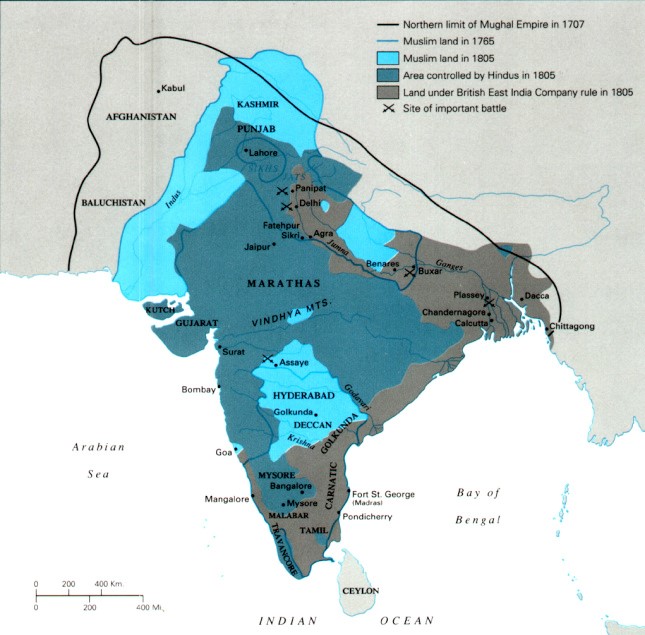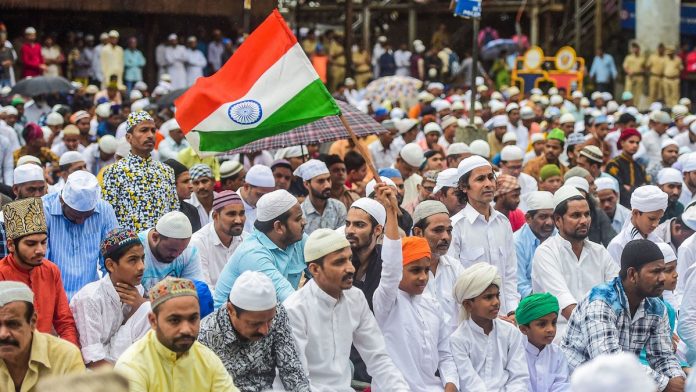Over the course of centuries, India has been the place where some of the major destructive ideologies of the world met their end. As the marauding Islamic armies conquered Mesopotamia, Anatolia, Persia etc., they met their match in India and were defeated and stopped from spreading further east. Also, despite Christian missionary attempts for several centuries and 200-year rule by the Christian British, Christians still form only a small minority in India. Further, while Marxism ruined China, Vietnam and many other developing Asian and African countries, it never could seize full political power in India.
Of course, it must be acknowledged that India has suffered immensely and continues to do so because of the trio of ideologies represented by the Marxist, the Missionary and the Mullah. Thanks to the relentless strife caused by virulent Islamic separatism, India has lost a large chunk of its former territories to entities such as Pakistan, Bangladesh etc. The same virulent strain continues to affect many regions of India today like Kashmir, Kerala etc. Similarly, a few of the North Eastern states have borne the misfortune of missionary activity and have become Christian-majority states. Also, thanks to Nehru’s fascination with Marxism and Fabian socialism, Marxists took over the education of Indians and succeeded in producing generations of deracinated, self-hating Hindus.
Thanks to such relentless assaults, the India of today is, in the words of V. S. Naipaul, truly a wounded civilisation. It is a mistake, however, to think the wounds are fatal. Nothing is written in stone in the field of human affairs. Like how Islam met its match in India, it is very much possible that secularism too can meet its end in India.
The colonised elite with fanatical, dogmatic minds
While no one can really know the inner workings of how human history works, it is certain that many have falsely claimed to have discovered such “secrets”. Marx claimed that all human history is a history of class struggle.[1] Such a reductive statement is fallacious to say the least. Class struggle may matter to some people at some time in their life, but not to all people always. Monotheist thinking reduces the vast complexity of human life into something simple which turns ultimately turns out to be destructive and meaningless. It is this fanatical thinking that gave birth to Christianity, Islam and Marxism.
Thanks to the decades of brainwashing of Marxist education, the colonised, educated Indians today promote Islam and Christianity as “progressive” and condemn Hindu Sanatana Dharma as “regressive”. A tolerant, colonised, educated Indian would even throw some crumbs at Sanatana Dharma and proclaim that although Sanatana Dharma is by nature evil and regressive, it can and should be reformed. This could perhaps free Sanatana Dharma from its impurities and make it clean and whole again! Such colonised minds have lost the ability to think independently and retain no self-respect when it comes to talking about the nature of Sanatana Dharma. Most of such colonised minds hold up secular liberalism as the ideal standard of today. Although such reformists may have good intentions, they fail to recognise the religious nature of secular liberalism, which is actually an outgrowth of Christianity.[2] The more radically colonised Indians end up adopting the religions of progressivism or communism, which can also be shown to be an outgrowth of Abrahamic monotheist fanaticism.[3]
Until the USSR stood, Indian progressives from Nehru[4] onwards held it up as the shining ideal of the new humanity to which India should aspire towards. As a result, the Indian state grew closer to the USSR during the Cold War and many Indians became heavily influenced by the communist propaganda emanating from there. In 1991, the USSR collapsed because of its internal contradictions. All the hype around the greatness of the Soviet communist model was shown to be based on fabrications and exaggerations. After 1991, although the colonised Indian elites lost their main source of joy and inspiration, all that was left is something today called secularism or “constitutional morality”. This is a code word referring to the erasing of the indigenous Sanatana political, cultural and religious expression and the imposition of an alien monoculture upon India.
The colonised Indian elites are today as religiously fanatic as any Taliban. Their worldview is based on several myths and fallacies. For example, some of the popular ones include:
- There was never any religious conflict in the 800 years of conflicts with Islamic invaders
- Hindu Sanatana Dharma and Indian social order in general are inherently evil because of “caste”
- Extreme leniency is the best way to deal with violent separatists and seditionists
- India must be forced to become
progressive in one of two ways:
- There needs to be a violent revolution in India along the lines of the French or Russian revolution
- Indian society needs to be reformed via more social engineering
Such fallacies can be dealt with as follows:
- The Muslim conquests brought about extreme religious persecution of the indigenous Hindus. Countless Hindus were murdered, and thousands of temples destroyed. Nearly all the Muslims of the Indian subcontinent are descended from Hindu ancestors.[5]
- Caste is a theoretical construct superimposed on Indian society by colonial intellectuals.[6] As such, the indigenous jati/varna system of India is a decentralised, self-regulating, autonomous system which has had both positives and negatives. Those who treat the jati/varna system as an “evil” only betray their genocidal bigotry and fanaticism.[7]
- Violent separatists and seditionists cannot be tolerated for a pluralist society to continue to exist. As Karl Popper put it: “In order to maintain a tolerant society, the society must be intolerant of intolerance”.
Myths of progress and reform

Finally, coming to the fallacy of progress, it is a myth mainly derived from the Abrahamic prophetic religions.[8] These religions divide all human history into 3 neat little phases:[9]
- The time of ignorance before the coming of the prophet
- Period after the coming of the prophet to save his followers
- Final deliverance day of judgement to save the believers and destroy the non-believers
Marx, Mohammed and Jesus all upheld the above threefold division of human history and all proclaimed that the believers (Proletariat, Muslims or Christians) will be saved on the day of judgement. This religious apocalyptic fanaticism provided the underpinning to the Jacobins of the French Revolution and the Bolsheviks of the Russian Revolution. [10] Following all these revolutions, an older ruling class was replaced by a newer, more ruthless ruling class who caused countless deaths using mass terror. Such violent uprisings have also been common in Christendom (e.g. Münster rebellion[11]) and Islam (e.g. genocide of Kashmiri Pandits in the name of “Azadi”[12] and the rise of ISIS) in anticipation of a final day of deliverance. In hindsight, these violent revolutions just caused immense suffering and did nothing to help with the economic wellbeing or the social welfare of the human beings who lived in those societies.
As far as the argument for social engineering and “reform” goes, most of the western countries have already been put through this process. The combined forces of excessive free market capitalism and the nanny state socialism have contributed to societies that are dying thanks to uncontrolled immigration[13] and the destruction of the family as a social unit.[14] Reforms are schemes to perform social engineering to reach some perceived lofty goals. However, all such schemes inevitably come with unintended consequences some of which can prove catastrophic. There is no rhyme or reason or limit to reform by top-down, authoritarian means. One can keep reforming until all civilisation ceases to exist and only chaos and anarchy prevail.
The Hindu Sanatana Dharmic alternative
In stark opposition to the recipes for disaster provided by the Marxist, the Missionary and the Mullah, the Sanatana view provides a holistic, all-encompassing framework that could help any country reach its full potential. Dharma, a Sanskrit word, has no equivalent in English. Its meaning is generally taken to refer to a set of principles mutually agreed upon for peaceful and prosperous coexistence in a society. Dharmocracy can be described as the rule of dharma which encompasses pluralism and concern for the environment as fundamental principles.
A central feature of the Hindu Dharmic system of governance is decentralisation. This helped to solve the problem of governing the large Mauryan empire. The system of self-sufficient rural republics was a unique feature of ancient India.
“The aloofness of the Indian village from high politics at the center attracted the attention of Megasthenes who has described how the bulk of the Indian population who were living on agriculture were exempt from military service and were often found freely working in the fields, even in sight of a battle raging close by.”
– Radha Kumud Mookerji[15]
Also, historically, the conception of a dharmic king was nothing like a tyrant. The king was always held accountable to the people and to the principles of dharma. The Vishnu Purana tells the story of king Vena, who fell from the path of dharma. He forbade sacrifices and the worship of Lord Vishnu. He was overthrown by a council of rishis (sages) as he had transgressed dharma. In the Arthashāstra, Kautilya has given broad outlines of the qualities of the ideal king as:
“The king’s happiness and welfare lie in the happiness and welfare of his subjects. He shall only take what pleases his subjects as good”.
– Kautilya[16]
Following such broad principles and also by adopting the insights provided by traditional scholars like Bharat Ratna P. V. Kane in his magnum opus, The History of Dharmaśāstra, the Hindu Dharmic alternative approach to governance can help to overcome the shortcomings of secularism, free market capitalism and state socialism.
Conclusion

It is an interesting historical counterfactual to think about how India could have been if the British colonisation never occurred. Before the coming of the British East India company, the Marathas were on the ascendant and had made the Mughals their vassals. There was a very likely possibility of a Hindu conquest of the whole of India. Seeing the political map of the India of the late 18th and early 19th centuries shows this to be much more than a mere thought experiment.
A government based on the principles of dharmic
pluralism and concern for the environment can truly help any country to develop
healthy social welfare and achieve economic progress. If such principles can be
integrated, true all-round development can be achieved for all. In the case of
the sister civilisation of India, China, it was able to unleash much of its true
potential and achieve greatness once the delusionary Marxist dogma was dropped
and a more pragmatic approach adopted in the 1980s. Similarly, it is very much
possible to envision an India, that is Bharat, which protects and promotes its own
scientific knowhow and its own indigenous religions and culture. Such an India can
be free of all its colonialist-inspired secular and progressive baggage and
instead be guided by the eternal, self-sustaining and indigenous principles of dharma.
[1] Marx, Karl. Manifesto of the Communist Party (1848)
[2] Holland, Tom. Dominion (2019)
[3] Charan, Jayant. “The Modern Religion Of Progressive Left Liberalism” (2019)
[4] Nehru, Jawaharlal. The Discovery of India (1946)
[5] Lal, K.S. Growth Of Muslim Population In Medieval India (1973)
[6] Fárek, Martin et al. Western Foundations of the Caste System (2017)
[7] Charan, Jayant. “Did The Caste System Save Hindus From Being Annihilated?” (2018)
[9] Gray, John. Black Mass (2008)
[10] Gray, John. Black Mass (2008)
[11] Charan, Jayant. “The Modern Religion Of Progressive Left Liberalism” (2019)
[12] “Filmmaker Anubhav Sinha tries to show separatist Azadi slogans did not come from Kashmir”
[13] Murray, Douglas. The Strange Death of Europe (2017)
[14] Thompson, Derek. “The Slow Death of ‘Traditional’ Families in America” (2013)
[15] Mookerji, Radha Kumud, Chandragupta Maurya And His Times (1943)
[16] Shamasastry, R. Arthashastra of Chanakya (1915)
Featured Image: The Print

